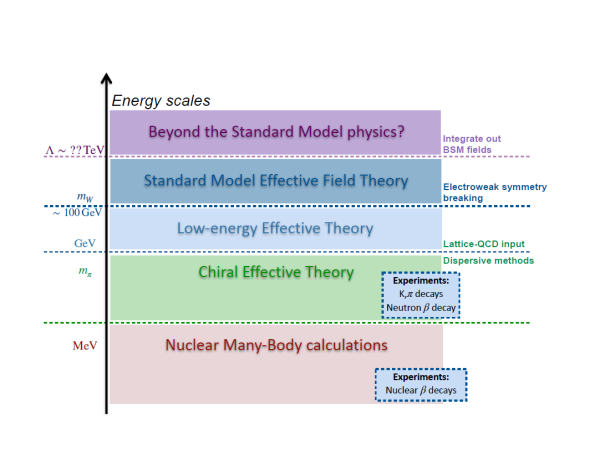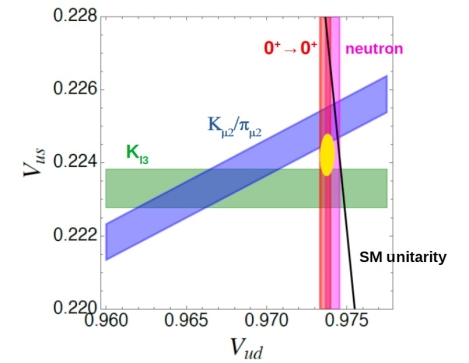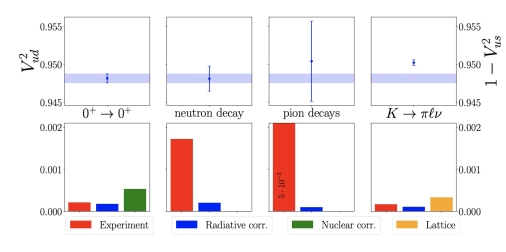Testing the Standard Model in Charged-Weak Decays

Event ID: INT-26-95W
Note: This is an in-person workshop. A $55.00 registration fee will apply. Please refer to your confirmation email for details and payment link.
Overview
Measurements of neutron and nuclear beta decays as well as kaon decays allow for the extraction of the so-called Cabibbo–Kobayashi–Maskawa (CKM) elements, which govern the charged-weak interactions in the SM. Recent years have seen a number of new theoretical calculations of these processes, which have revealed a discrepancy between the SM prediction and the experimental measurements. In light of these developments, there has been renewed interest in (re)assessing all relevant theoretical uncertainties. At the same time, there is a vibrant experimental program that aims to decrease the uncertainties as well as perform measurements that can provide useful input to theory calculations.
All of these efforts are essential in establishing whether the uncovered tensions between experiment and theory are due to physics beyond the SM. Regardless of whether the current discrepancy survives future scrutiny, the sub-permille uncertainties imply that kaon and beta decays are sensitive to minuscule effects of BSM physics. This sensitivity corresponds to probing BSM mass scales of up to 10 TeV, which is competitive with other experiments such as high-energy colliders like the LHC.
The rapid development in the field of charged-current interactions, Vud, Vus, and new physics searches makes it apparent that a more formal collaboration between theorists and experimentalists in different subfields of nuclear and particle physics is urgently needed. This workshop aims to provide an update to the community on the most recent experimental and theoretical developments regarding the extraction of Vud and Vus. In the u-d sector, this includes the measurement of the semileptonic pion decay branching ratio, the neutron lifetime and axial coupling constant, the branching ratios of allowed/superallowed nuclear beta decays. Status of several long-standing discrepancies, such as the neutron lifetime puzzle and inconsistencies in gA determinations will be addressed. For strangeness-changing processes, the status of kaon leptonic and semileptonic decays, tau decays, and hyperon decays will be covered. The status of all the SM theory inputs associated to these processes will also be summarized. This includes the data-driven and lattice determinations of the single-nucleon gamma-W box diagram, the ab-initio studies of the nuclear-structure dependent radiative corrections and isospin-breaking corrections in Fermi and Gamow-Teller transitions, lattice calculation of neutron axial coupling constant and its radiative corrections, kaon-to-pion decay form factor, ISB correction and theory inputs for other rare decays relevant for Vus extraction. In addition, the discussions during the workshop will allow different communities to interact and foster collaborations. Finally, one of the main points of discussion will be the possibility of a formal collaboration involving both theorists and experimentalists in the spirit of the previously proposed VUDU (+ Vus) alliance, which is a topical group that would "foster further collaboration, strengthen theory benchmarking efforts, amplify the impact of focused experimental efforts, and sustain the leadership role of the nuclear beta decay community in precision CKM unitarity tests". Such a discussion would allow the community to consider how to organize itself in order to keep track of and collect future experimental and theoretical results.
Event Format
This will be an in-person workshop with a few 45-minute talks a day. In addition, a significant amount of time will be reserved for discussion sessions in the afternoon. We plan to include perspectives from both the experimental and theoretical sides. The preliminary topics include:
- Vus and single-hadron decays;
- Vus and nuclear decays; Strangeness-changing processes and Vus;
- Global analysis, implications for BSM physics;
- Future prospects, writing session
As mentioned above, apart from “reporting the present”, an equally important goal for this workshop is to “plan for the future” by identifying topics of interest for immediate theoretical and experimental studies, and to foster collaborations between experimentalists and theorists.



